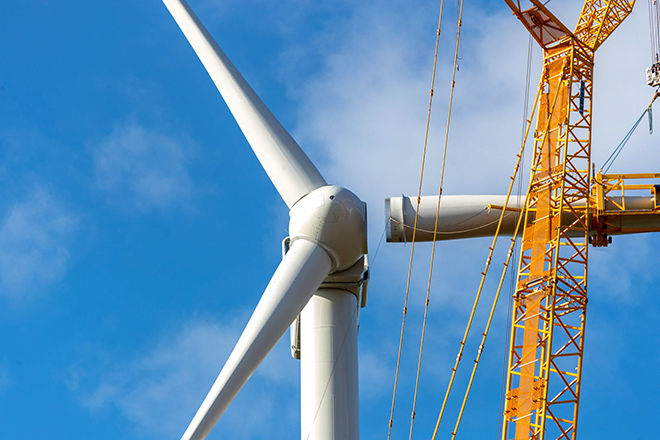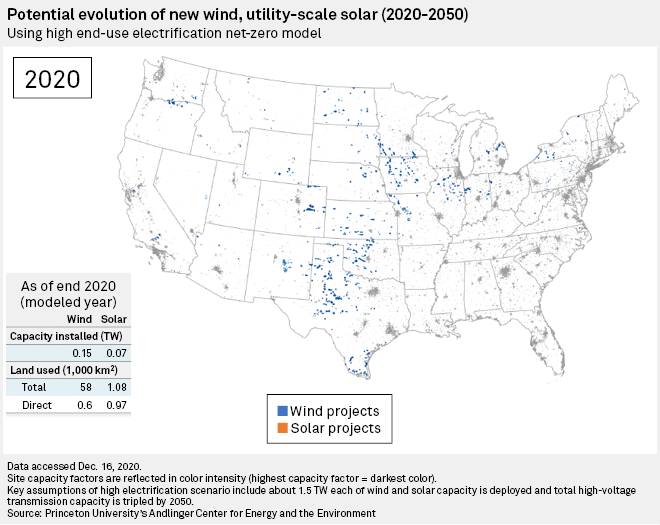
| An onshore wind turbine being assembled. A recent study found that for the U.S. to achieve net-zero emissions by 2050, a massive increase in wind and solar generation and new transmission capacity would be needed. Source: Joakim Lagercrantz, OX2 |
A recent study found that the U.S. could achieve net-zero emissions by 2050 with a minimal increase in spending if all parties involved get the ball rolling immediately. But energy experts, and even one of the study's authors, acknowledged that the scenarios the study outlined are best-case and would require major shifts in federal and state policies, permitting, capital allocation and even the public will.
The mid-December report led by the Princeton University's Andlinger Center for Energy and the Environment outlined five scenarios under which the U.S. could achieve net-zero emissions by 2050 with energy-related spending in line with historical levels as a share of economic activity, or between 4% to 6% of GDP.
The five scenarios assume varying levels of end-use electrification, wind and solar development, fossil fuel use, carbon capture and sequestration, infrastructure development, hydrogen and synthetic fuel production, biomass supplies, electric vehicle adoption, and land sinks to absorb carbon through agricultural practices and forest management.
The modeling for the study assumed "perfect coordination across the country and perfect foresight as to where we're going," said study co-author Jesse Jenkins, an assistant professor of mechanical and aerospace engineering at Princeton. "In reality, we're going to be on a bumpier path and it's going to be a little slower ... and it might be a little more costly."
Study could inform Biden administration's strategy
The study comes a month before President-elect Joe Biden is scheduled to be sworn in and as a number of major companies, including in energy, have announced net-zero targets. For his part, Biden has pledged to set the U.S. on a path to carbon-free electricity by 2035 and net-zero economywide emissions by 2050.
"Change is coming," said Larry Gasteiger, executive director of the pro-transmission group WIRES and a former chief of staff at the Federal Energy Regulatory Commission. "With the new administration coming in, the timing is perfect to start looking at these issues afresh. There's a need to get things really moving fast" and to stop talking about what needs to be done and start doing it.
Study co-author Jenkins said the report was purposefully agnostic about the policies needed to achieve the net-zero scenarios. A half-dozen policies could achieve any one recommendation, Jenkins suggested. The value of the study is that it gives regulators, lawmakers and companies a scenario to grade their policy or plans against to see if they achieve the needed objectives, Jenkins said.
The study did make some broad policy observations. For instance, it called for electricity market reforms to ensure reliability and "to value flexibility on both the supply side and the demand side."

Two big hurdles to the net-zero pathways envisioned in the study include whether the nation can quickly site and build the needed renewable generation and transmission lines, said energy infrastructure and market experts.
Other bottlenecks the report listed as needing "immediate attention" included community opposition to infrastructure, developing a skilled workforce at the pace required to meet the transition, building out supply chain capabilities, ensuring regulators can review and permit investment proposals at the scale and pace needed, lowering upfront cost premiums such as for electric vehicles and electric heat pumps that can provide grid balancing services, and the need to de-risk at-risk capital to accelerate project development and construction activities.
Under the high-electrification scenario in the study, about 300 GW each of new wind and solar would need to be built by 2030 and 1.5 TW each of new wind and solar capacity would be needed by 2050, which would collectively cost about $3.2 trillion. To get all of that new generation to customers, the capacity of the high-voltage power grid would need to increase by about 60% by 2030 and triple from current levels by 2050 at a price tag of about $2.4 trillion.
To put that level of expansion in context, 2020 estimated capital expenditures for electric transmission and distribution infrastructure for U.S. electric and multi-utility holding companies as of November were projected to reach $54.52 billion and to increase by about 5% in 2021, a modest change compared to the scale-up called for in the Princeton study.
New transmission faces big hurdles
Experts called into question whether high-voltage lines can be built at the speed envisioned by the high-electrification scenario. Transmission lines often take 10 years from start to finish, which means "we're almost out of time" for the 2030 transmission target, Gasteiger said.
Moreover, "there's no shortage of challenges to getting transmission built, particularly bigger high-voltage projects," Gasteiger said. Challenges include the siting and permitting processes and cost allocation.
Gasteiger suggested the Biden administration, through agencies such as FERC, could help get the ball rolling. Steps FERC could take include finalizing its pending rule on transmission rate incentives and revamping Order 1000, which established new regional grid planning requirements but failed to prompt big interregional projects of the sort the net-zero study envisioned.
Beyond FERC, Jenkins believes that "there's a lot the administration could do but probably not enough without congressional action." For example, congressional approval will be needed for things such as federal funding for workforce development programs and to help communities affected by the clean energy transition, said Erin Mayfield, a postdoctoral researcher at the High Meadows Environmental Institute, who led the employment and air pollution analysis in the study.
Another example of where federal agencies can help would be having the U.S. Environmental Protection Agency under its Clean Air Act authority and the U.S. Department of Transportation under Corporate Average Fuel Economy, or CAFE standards, increase emissions standards to get the nation on track to have the incentives needed to switch to electric vehicles, Jenkins said. But congressional action would be needed to subsidize the costs of electric vehicle purchases through tax credits, Jenkins said.
Another potential problem with the report is that all of the scenarios included retiring all coal-fired generation by 2030, whereas only about half of the fleet is expected to do so by then, said Sue Tierney, a senior adviser for economic consulting firm Analysis Group. Closing down the coal fleet countrywide could present some reliability challenges in pockets of the U.S., Tierney said.



